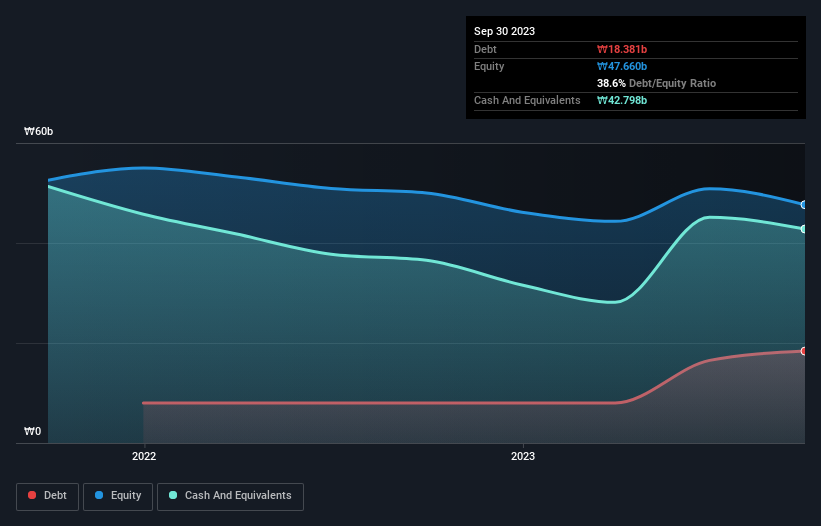
Howard Marks put it nicely when he said that, rather than worrying about share price volatility, 'The possibility of permanent loss is the risk I worry about... and every practical investor I know worries about.' So it seems the smart money knows that debt - which is usually involved in bankruptcies - is a very important factor, when you assess how risky a company is. Importantly, Curacle Co., Ltd. (KOSDAQ:365270) does carry debt. But the real question is whether this debt is making the company risky.
When Is Debt A Problem?
Debt and other liabilities become risky for a business when it cannot easily fulfill those obligations, either with free cash flow or by raising capital at an attractive price. Part and parcel of capitalism is the process of 'creative destruction' where failed businesses are mercilessly liquidated by their bankers. However, a more usual (but still expensive) situation is where a company must dilute shareholders at a cheap share price simply to get debt under control. Having said that, the most common situation is where a company manages its debt reasonably well - and to its own advantage. When we examine debt levels, we first consider both cash and debt levels, together.
See our latest analysis for Curacle
What Is Curacle's Debt?
The image below, which you can click on for greater detail, shows that at September 2023 Curacle had debt of ₩18.4b, up from ₩8.00b in one year. However, its balance sheet shows it holds ₩42.8b in cash, so it actually has ₩24.4b net cash.

A Look At Curacle's Liabilities
Zooming in on the latest balance sheet data, we can see that Curacle had liabilities of ₩1.54b due within 12 months and liabilities of ₩23.3b due beyond that. Offsetting this, it had ₩42.8b in cash and ₩3.18b in receivables that were due within 12 months. So it can boast ₩21.1b more liquid assets than total liabilities.
This short term liquidity is a sign that Curacle could probably pay off its debt with ease, as its balance sheet is far from stretched. Simply put, the fact that Curacle has more cash than debt is arguably a good indication that it can manage its debt safely. The balance sheet is clearly the area to focus on when you are analysing debt. But you can't view debt in total isolation; since Curacle will need earnings to service that debt. So when considering debt, it's definitely worth looking at the earnings trend. Click here for an interactive snapshot.
Over 12 months, Curacle reported revenue of ₩10b, which is a gain of 14%, although it did not report any earnings before interest and tax. We usually like to see faster growth from unprofitable companies, but each to their own.
So How Risky Is Curacle?
By their very nature companies that are losing money are more risky than those with a long history of profitability. And we do note that Curacle had an earnings before interest and tax (EBIT) loss, over the last year. Indeed, in that time it burnt through ₩17b of cash and made a loss of ₩11b. But at least it has ₩24.4b on the balance sheet to spend on growth, near-term. Overall, its balance sheet doesn't seem overly risky, at the moment, but we're always cautious until we see the positive free cash flow. There's no doubt that we learn most about debt from the balance sheet. But ultimately, every company can contain risks that exist outside of the balance sheet. For example, we've discovered 1 warning sign for Curacle that you should be aware of before investing here.
At the end of the day, it's often better to focus on companies that are free from net debt. You can access our special list of such companies (all with a track record of profit growth). It's free.
Valuation is complex, but we're here to simplify it.
Discover if curacleltd might be undervalued or overvalued with our detailed analysis, featuring fair value estimates, potential risks, dividends, insider trades, and its financial condition.
Access Free AnalysisHave feedback on this article? Concerned about the content? Get in touch with us directly. Alternatively, email editorial-team (at) simplywallst.com.
This article by Simply Wall St is general in nature. We provide commentary based on historical data and analyst forecasts only using an unbiased methodology and our articles are not intended to be financial advice. It does not constitute a recommendation to buy or sell any stock, and does not take account of your objectives, or your financial situation. We aim to bring you long-term focused analysis driven by fundamental data. Note that our analysis may not factor in the latest price-sensitive company announcements or qualitative material. Simply Wall St has no position in any stocks mentioned.
About KOSDAQ:A365270
curacleltd
Curacle Co., Ltd., a bio-venture business, engages in the research and development of drugs for diseases caused by aging process and damage to blood vessels.
Flawless balance sheet very low.
Market Insights
Community Narratives



